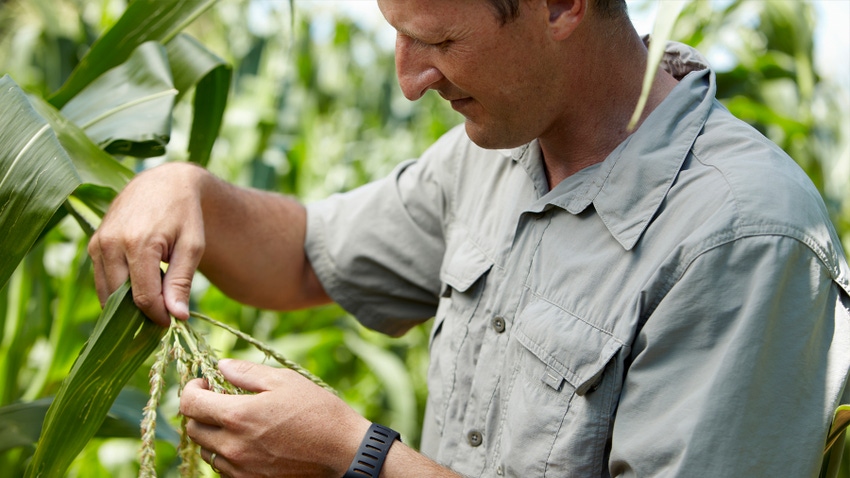
The devil is in the details when it comes to making a successful management plan to increase corn yields and even hit those 300-bushel yields. South Dakota State University Extension specialists give farmers eight recommendations to optimize yields and profits in their fields:
1. Try out on-farm research plots. Learning what works on your operation can give you insight on products, management and factors that offer top yields. Farmers can do their own on-farm research on new products being released each year to determine which ones fit into their existing management plans. Even if new products fail, the information gained in the long run will help.
2. Find limiting factors. With variability common even between neighboring fields, cropping problems aren’t uniform and a one-size-fits-all solution may not bring the best results. Fields should be scouted often and more so during high-risk periods when disease pressure is optimal, or weeds are emerging. Drones or other aerial imaging can help find trouble spots while saving on labor.
Lodging is one limiting factor that can take years to rectify. Harvesting against lodging should be considered until the issue is resolved. SDSU offers possible solutions:
decreasing seeding rates
seeding hybrids with a quick drydown time
using a hybrid with increased stalk rot and insect resistance
planting a crop with a shorter maturity rating
3. Keep records of success. A detailed record of successful hybrids and plant population rates are just a few things farmers can reference from year to year.
As for corn hybrids, choose the types that work best for you. A “racehorse” produces high yields in excellent condition, but lower yields in poor conditions. A “workhorse” produces good yields on either end of the condition spectrum. A “defensive” hybrid often produces high yields with poor conditions, but lower in good conditions than racehorses or workhorses. Rather than planting the same variety across a field, consider variable seeding with a hybrid in low- or high-yielding spots with the right type of variety.
Also, consider reducing row spacing, with narrow spacing bringing rapid canopy closure, reduced evaporation and weed pressure. Narrow spacing, however, brings the difficulties of increased compaction risk and difficulty on fertilizer and pesticide applications.
4. Manage crop residue. Optimize seed germination with best residue management. SDSU says that corn residue has doubled as a result of yield increases. Leaving residue has caused an increase of soil organic matter in South Dakota fields, while higher residue can bring problems of its own.
Reduce these problems by chopping residue with a chopper or chopping combine header. Adopt tillage techniques that minimize contact such as strip tillage. Harvesting or baling residue has been widely adopted but brings the potential for soil erosion and nutrient deficiencies. Consider pros and cons of what type of residue management fits into your operation.
5. Work with water. Water-use efficiency has been linked to higher corn yield in South Dakota over the past 40 years. New hybrids are also being developed to improve water efficiency. If drought conditions are a limiting factor, consider installing irrigation, using drought-tolerant hybrids or reducing tillage intensity. Less tillage is one of the most economical ways to save water, according to SDSU.
6. Improve soil nutrients. Soil-testing fields is the best way to assess what nutrients are available to crops. Again, with variable conditions likely across a field, utilize a precision grid sampling to define variability and save time and money when applying nutrients.
SDSU says if soil testing shows, for example, phosphorus values have increased from year to year, a reduction in P application rates should be considered.
In addition to soil testing, tissue sampling or remote sensing through precision technologies such as aerial or drone imaging can be used to assess the effectiveness of a nutrient program.
7. Knock out weeds, pests and diseases. Scouting incidences of disease and pests from year to year can give you a leg up on problems in the next growing season. New infestations can be traced back to poor equipment cleaning, so preventive measures must be considered.
Weeds present during the V1 to V6 stage of corn growth can reduce yields. Preemerge herbicide should be applied to minimize early weeds, and farmers should apply a postemerge herbicide if further control is needed. With early planting optimizing yields, seed treatments of fungicide and insecticides are recommended. Tie this work together by choosing a hybrid possessing appropriate traits.
8. Prep equipment. With planters considered to be the most important machinery on the farm, SDSU says the equipment must be in perfect condition to obtain top yields. Testing and calibration of planters should be done annually. Chemical application also should be calibrated, as a poor adjustment can lead to too much or too little being applied.
While the journey to 300-bushel corn yields varies from farm to farm, taking these tips to create a strategy can help increase the yields and profits on your operation.
South Dakota State University Extension contributed to this article.
Read more about:
ExtensionAbout the Author(s)
You May Also Like






